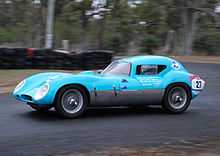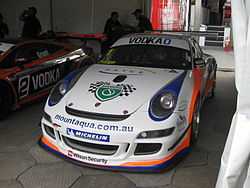Australian GT Championship
 | |
| Category | Sports car racing |
|---|---|
| Country | Australia |
| Inaugural season | 1960 |
| Drivers | 49 |
| Drivers' champion |
|
| Official website | Australian GT |
|
| |
The Australian GT Championship is a CAMS-sanctioned national title for drivers of GT cars, held annually from 1960 to 1963, from 1982 to 1985 and from 2005. Each championship up to and including the 1963 title was contested over a single race and those after that year over a series of races. The category has not always been well defined and often has become a refugee home for competitors and cars orphaned by category collapse or a sudden change in regulation.
Appendix K

In the first era the championship races were open to closed roof cars (not necessarily production based) complying with CAMS Appendix K regulations. Appendix K catered for modified production Grand Touring cars (such as Lotus Elite), sports cars (such as Jaguar D-Type) fitted with roofs, specials (such as the Centaur Waggott) and touring cars modified beyond the limits of the then current Appendix J regulations. Numbers dropped rapidly away as the years went on and the class was left behind in 1963.
GT/Sports Sedan
From 1976 to 1981 the Australian Sports Car Championship had been contested by Group D Production Sports Cars. The re-introduction of Group A Sports Cars in 1982 saw Group D needing a new home. The Australian GT Championship was re-introduced as a home for both Group D and Group B Sports Sedans of the Australian Sports Sedan Championship. The category was something of a hybrid with European racing cars, American IMSA racers and wide variety of Australian Sports Sedans competing together. One major difference between the Sports Sedans and GT cars was that the Sports Sedans were restricted to 10" wheels where as the GT cars were allowed up to 18" of rubber. Although many of the top V8 sports sedans had similar power to the GT cars, the difference in rubber on the road saw the GT cars able to get their power to the ground much more efficiently and also go much faster through the turns.
Porsche 935's dominated early with 1980 Formula One World Champion Alan Jones winning the 1982 Championship in an entry backed former race driver Alan Hamilton's Porsche Cars Australia (Hamilton was Australia's major Porsche distributor at the time). Porsche won again in 1983, this time with Rusty French driving the 1982 title winning car he had acquired from Hamilton, while both the 1984 and 1985 championships were won by Allan Grice and Bryan Thomson respectively, both driving the ex-Bob Jane DeKon Chevrolet Monza with a 6.0 L V8 engine that produced a reported 600 bhp (447 kW; 608 PS), with Thomson also driving his exotic Chevrolet V8 powered twin turbo Mercedes-Benz 450 SLC in the 1985 series. The Thomson Mercedes was alleged to produce over 1,000 bhp (746 kW; 1,014 PS) making it arguably the most powerful race car in Australian motor racing. The downside though was the Mercedes suffered numerous reliability (turbo) problems and rarely showed its true potential.
As time went on the usually slower Sports Sedans started to usurp the category as the more expensive Sports Car refugees dropped in numbers. Sports Sedans also became more effective, especially once local racing car factories and professional racing teams like Elfin Sports Cars, K&A Engineering, Allan Browne's Re-Car team and JPS Team BMW became involved. As with Appendix K of the 1960s, grids were widely varied with turbocharged Porsche 935's, BMW 318i's, 5.0 and 6.0 litre V8 powered Chevrolet Monza's, Holden Commodores, Alfa Romeo Alfettas, Thomson's lone Mercedes-Benz 450 SLC, Peter Fitzgerald's Porsche Carrera RSR, a couple of V12 Jaguar XJS' and with a variety of sports sedans such as the Holden Monaro and Holden Torana, Ford Falcon and Ford Escort, and various turbocharged Toyota's, Nissan's and Mazda RX-7's.
By 1985 the field was mostly Sports Sedans bolstered with recently obsolete Group C Touring Cars and the championship was run concurrently with the Sports Car Championship. Veteran driver Kevin Bartlett introduced a very quick Ground effects De Tomaso Pantera in 1985 which brought some much needed spice to the GT category.
For 1986 Sports Sedans went their own way. Within a couple of years Porsche drivers had their own series with the Porsche Cup.
GT3


The Australian GT Championship was revived a second time in 2005 after the disbandment of the Australian Nations Cup Championship. Most of the competing 2004 cars remained eligible for 2005, although the controversial Holden Monaro 427C's which had won the two Bathurst 24 Hour races in 2002 and 2003 were a notable exception. This was because the Monaro's under Nations Cup rules had been permitted to use the 7.0 litre, 427 cui LS6 Chevrolet V8 engine that had been used successfully in the Chevrolet Corvette C5-R, while the road going CV8 Monaro's only came with the 5.7 litre Gen III V8.
The FIA GT3 regulations, like those in use in the FIA GT3 European Championship was the core of the new series. The series vehicles reflected GT3, Porsches, Ferraris, Lamborghinis, the controversial Mosler, although series regulations usually specified cars be two-three years old to cut down on costs. Competing drivers are seeded and penalised so as not to flood the series with professional drivers from other categories and increasing there has been an emphassis on longer races, sometimes allowing for more than one driver per car.
Champions
| Season | Champion | Vehicle |
|---|---|---|
| 1960 | |
Lotus Elite |
| 1961 | |
Jaguar D-Type |
| 1962 | |
Centaur Waggott |
| 1963 | |
Jaguar E-Type |
| 1964–1981 | Not Contested | |
| 1982 | |
Porsche 935 |
| 1983 | |
Porsche 935 |
| 1984 | |
Chevrolet Monza |
| 1985 | |
Chevrolet Monza Mercedes-Benz 450 SLC – Chevrolet |
| 1986–2004 | Not Contested | |
| 2005 | |
Porsche 996 GT3 Cup |
| 2006 | |
Dodge Viper GTS ACR |
| 2007 | |
Ferrari 360 GT Ferrari 430 GT3 |
| 2008 | |
Lamborghini Gallardo GT3 |
| 2009 | |
Porsche 997 GT3 Cup S |
| 2010 | |
Porsche 997 GT3 Cup S |
| 2011 | |
Audi R8 LMS |
| 2012 | |
Porsche 997 GT3-R |
| 2013 | |
Porsche 997 GT3-R |
| 2014 | |
Mercedes-Benz SLS AMG |
References
- A History of Australian Motor Sport, © 1980
- Australian Motor Racing Yearbooks, 1982/83 to 1985/86
- www.camsmanual.com.au
- www.gtchampionship.com.au
External links
| ||||||||||||||